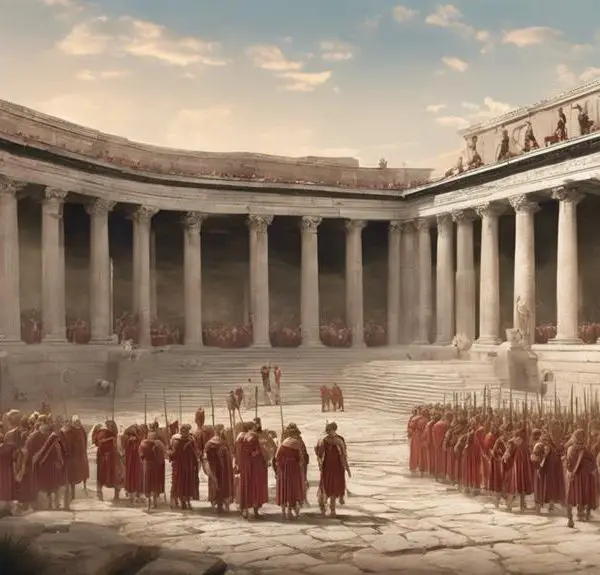Discover how the Bible's vivid stories unlock the power of imagination, inviting a deeper exploration of faith and the human spirit.

Power of Imagination in the Bible
In the digital age, you might not immediately connect the dots between the ancient scriptures and the power of imagination. Yet, the Bible is a treasure trove of stories that ignite the mind, from the vivid creation narratives to the cryptic visions of the apocalypse.
You'll find that the dreams of patriarchs, the parables of Jesus, and the apocalyptic revelations all showcase how imagination bridges the gap between the divine and the mundane. Consider how these stories might expand your own understanding of faith and creativity.
Let's explore this intersection and discover what it reveals about the human spirit.
Key Takeaways
- The Bible uses vivid imagery and symbols to explore deep spiritual truths and divine mysteries.
- Dreams and visions serve as divine communication, guiding and revealing God's plans to humanity.
- Jesus' parables engage the imagination, challenging listeners to rethink societal norms and personal beliefs.
- Apocalyptic literature employs dramatic symbolism to convey messages of hope, justice, and the ultimate triumph of good over evil.
Imagery in Creation Narratives

In the creation narratives, vivid imagery unfolds, inviting you to explore the depth and richness of the universe's genesis through a theological lens. The texts aren't just stories; they're a canvas painted with the strokes of divine craftsmanship, illustrating the meticulous and purposeful design of the cosmos. As you delve deeper, you encounter symbolic landscapes that aren't mere backdrops but imbued with meaning, reflecting the profound relationship between the Creator and creation.
Through these narratives, you're introduced to a world where every element, from the expansive skies to the teeming life in the seas, is a testament to divine artistry. The symbolism extends beyond the physical, inviting you to ponder the spiritual underpinnings of existence itself. These landscapes serve as metaphors for the divine order and the potential for harmony within the created world.
The emphasis on divine craftsmanship in the creation stories offers a lens to view the world as a masterpiece of intricate design, challenging you to appreciate the sacredness of life and the environment. The symbolic landscapes, in turn, beckon you to consider deeper truths about your place in the universe and the purpose of creation. This analytical journey enriches your understanding, fostering a faithful appreciation of the biblical narrative's complexity and beauty.
Dreams of Patriarchs and Prophets

Moving beyond the divine artistry of creation, we now explore how the Bible uses dreams to reveal the intentions and guidance of God through the experiences of patriarchs and prophets. This method of divine communication not only emphasizes the power of imagination but also highlights the deep, spiritual connection between God and His chosen individuals.
- Joseph's foresight into the future of Egypt through dreams of sheaves and stars not only saved nations from famine but also showcased the depth of God's strategic planning.
- Daniel's interpretation of Nebuchadnezzar's dreams revealed not just immediate futures but the unfolding of divine will across empires, demonstrating God's sovereignty over time and nations.
- Jacob's dream of a ladder reaching to heaven symbolizes the connection between God and humanity, illustrating a pathway to divine presence and guidance.
- Samuel's prophetic call as a child, initiated through a dream, signifies the personal and direct nature of God's communication, affirming His ongoing engagement in the lives of His people.
Through these narratives, the Bible illustrates that dreams aren't mere figments of the imagination but are potent tools for revelation, guidance, and prophecy. They embody the intricate ways God communicates His will, offering both comfort and challenge to those who dare to listen.
Parables and Metaphors of Jesus

Jesus' use of parables and metaphors masterfully unveils the mysteries of the kingdom of heaven, inviting you into a deeper understanding of divine truths. Through these storytelling techniques, He doesn't just tell you what the kingdom is like; He shows you, employing everyday scenarios you can easily relate to. This approach doesn't merely inform; it transforms, pushing you to think and reflect deeply.
His parables, rich with moral lessons, aren't just ancient tales. They're timeless narratives that challenge societal norms and provoke self-examination. Consider the Parable of the Good Samaritan, which critiques societal prejudices and redefines the concept of neighborly love. It's a direct call to action, urging you to transcend societal boundaries of ethnicity and religion in showing mercy and compassion.
Similarly, the Parable of the Prodigal Son offers a profound insight into forgiveness and redemption. It's a societal critique on judgment and exclusion, showcasing a father's unconditional love as a metaphor for divine forgiveness.
Through these stories, Jesus doesn't only aim to teach. He invites you into an imaginative exploration of faith, urging you to envision a world where moral lessons triumph over societal prejudices.
Visions in Prophetic Literature

Prophetic literature in the Bible unfolds through vivid visions, offering you a glimpse into divine plans and mysteries beyond human understanding. These passages aren't just mere stories; they're a form of divine communication, rich in symbolic interpretation. You're invited to explore these complex messages, understanding that each symbol and scenario plays a critical role in conveying God's messages to humanity.
In the realm of prophetic visions, consider the following imagery:
- Fiery chariots and whirlwinds symbolizing God's power and the transportation of prophets between the earthly and the divine.
- Valleys filled with dry bones coming to life, representing the restoration of Israel and the breath of life from God.
- Rivers flowing from the temple depicting the outpouring of divine blessings and the spread of God's teachings.
- Four-faced creatures embodying the omnipresence and omniscience of God, observing and acting in every direction.
These visions serve multiple purposes: they reassure, warn, guide, and sometimes, even challenge the audience. The symbolic interpretation of these visuals opens a door to deeper understanding and reflection on divine communication. It's a journey into the heart of faith, where imagination meets the infinite.
Apocalyptic Revelations Unveiled

Exploring further, we now encounter the realm of apocalyptic revelations, where visions become even more vivid, unveiling the ultimate destiny of the world and humanity's place within it. This section of Biblical narrative delves into the complex interweaving of end time symbolism and judgment scenarios, challenging you to interpret and understand the profound messages encoded within.
The apocalyptic literature, particularly in books like Revelation, uses symbolism extensively, painting scenarios of cosmic battles, divine judgments, and the ultimate restoration of creation. These symbols aren't just there for dramatic effect; they serve a deeper purpose, guiding you to reflect on the moral and spiritual condition of humanity. The imagery of beasts, seals, trumpets, and bowls, for example, isn't merely fantastical; it's a coded language designed to reveal truths about human nature, divine justice, and the hope of redemption.
In dissecting these judgment scenarios, you're invited to consider the consequences of moral and spiritual choices. The vivid descriptions of the end times aren't just warnings; they're an invitation to transformation, urging you to align your life with divine principles. Through the lens of apocalyptic revelations, you're encouraged to visualize not just the potential for destruction, but the promise of a new creation, where justice, peace, and righteousness prevail.
Frequently Asked Questions
How Does the Concept of Imagination Differ Between Old Testament and New Testament Contexts?
You're exploring how imagination is portrayed differently in the Old and New Testaments.
In the Old Testament, imagination often manifests through prophetic visions, serving as a direct channel for divine messages.
In contrast, the New Testament frequently utilizes creative parables, a method Jesus used to teach spiritual truths metaphorically.
This shift reflects a broader engagement with imagination, moving from divine revelation to metaphorical storytelling to convey complex theological concepts.
Can the Power of Imagination Be Considered a Gift From God, and if So, How Should It Be Used According to Biblical Principles?
Absolutely, your imagination can be seen as a divine gift, guiding you to use it within the bounds of creative worship and imaginative prayer.
When you channel this gift, it's crucial to align your creative expressions with biblical teachings, ensuring they serve to glorify God and edify others.
This approach not only honors the gift's origin but also deepens your spiritual practice, fostering a richer, more meaningful connection with the divine.
Are There Any Biblical Figures Who Were Cautioned or Punished for Misusing Their Imagination?
Yes, the Bible warns against misusing your imagination. For example, in Genesis, the Tower of Babel's builders overstepped creative boundaries, leading to their dispersion.
Similarly, King Saul faced consequences for not following God's commands, highlighting the need for imaginative repentance. These stories teach that while imagination is a gift, it must align with divine will, cautioning against pride and encouraging humility and obedience within the scope of creativity.
How Does the Bible Address the Limits or Dangers of Human Imagination in Relation to Idolatry and False Beliefs?
The Bible cautions against the dangers of human imagination, particularly highlighting the risks of creative idolatry and imaginative heresy. You're warned that letting your imagination run wild can lead to crafting false gods and beliefs, distancing you from the truth.
This isn't just about physical idols but also encompasses any concept or ideology that replaces or distorts your understanding of the divine. It's a call to remain vigilant and faithful, avoiding the pitfalls of unfettered imagination.
In What Ways Does Contemporary Christian Theology Interpret the Role of Imagination in Understanding and Experiencing God Beyond the Scriptural Narratives Mentioned?
You're exploring how contemporary Christian theology sees imagination's role in understanding and experiencing God.
This viewpoint encourages Imaginative Prayer and Creative Worship, allowing you to engage deeply with divine mysteries beyond literal interpretations.
These practices aren't just about retelling stories; they're about placing yourself within them, fostering a personal and transformative encounter with the divine.
It's a scholarly approach that honors faithfulness while embracing analytical thinking.
Conclusion
Throughout the Bible, the power of imagination weaves a rich tapestry, from the vivid creation narratives to the transformative dreams of patriarchs and prophets.
Jesus' parables and metaphors engage the mind, inviting deeper reflection on spiritual truths. The prophetic literature and apocalyptic revelations further unveil the unseen, challenging you to envision a realm beyond the physical.
This divine imagination acts as a bridge, connecting you to the mysteries of faith, urging a deeper, more profound understanding of the divine narrative.



Sign up